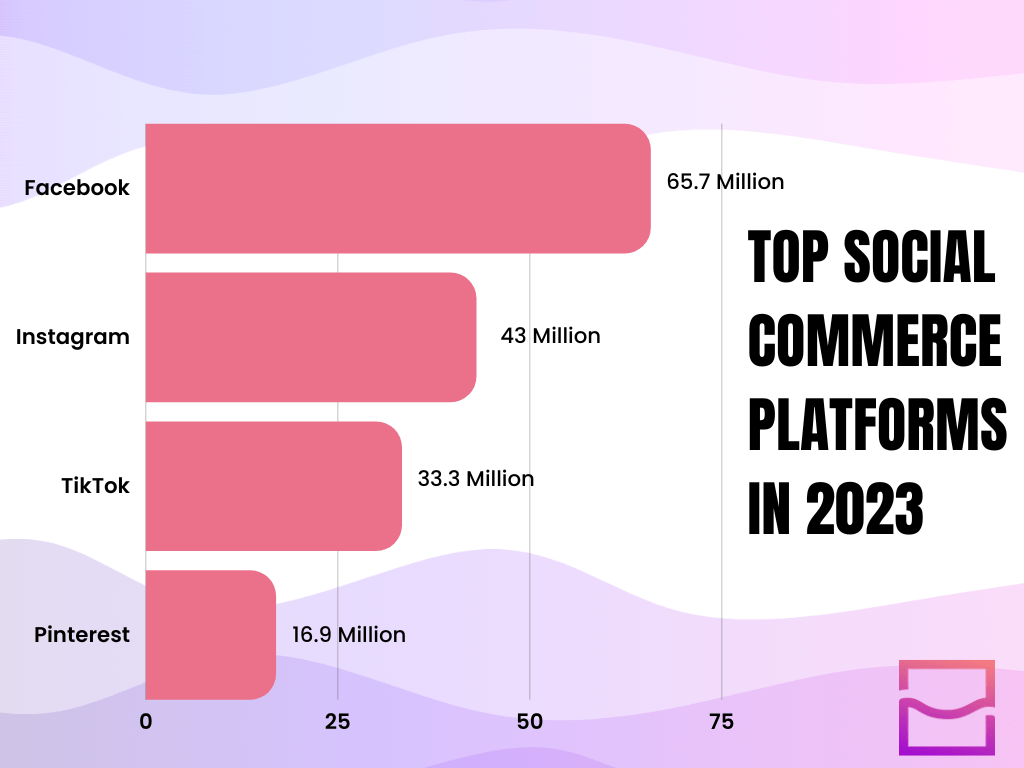Why Social Commerce Is Primed for Growth
How to Be the Next #TikTokMadeMeBuyIt Success Story.
There’s a hashtag making the rounds, #TikTokMadeMeBuyIt, that’s pretty relatable. Even if TikTok isn’t your particular social media du jour, we’ve all seen something on Instagram or YouTube that we suddenly had to have. We live in an era where instant gratification is achievable. It’s never been quicker and easier to go from seeing some new kitchen gadget, to wanting it, to having it shipped to you overnight – or even the same day. That’s why so many businesses are capitalizing on the ability of social media platforms to generate consumer awareness and drive conversion in mere minutes.

Social commerce is expected to be an $80 billion business by 2025 in the U.S. alone. But it’s a bit different from regular old ecommerce. It’s sort of a subsection. Social commerce is the use of a social media platform like Facebook and Instagram to market and sell products and services without the user ever leaving the app. Social commerce accounts for 10% of all ecommerce sales, but its percentage is expected to grow to 17% within the next three years.
Social commerce is booming because of the rise of social media users and the development of new easier-than-ever purchasing methods. Research shows the typical social media user now spends about 15% of their waking life on social platforms, with 10% of US adults having an addiction to at least one app.
Social commerce is more complicated than it seems, though. It requires you to build your brand and drive conversions simultaneously. For marketers and agencies that’s the #1 challenge, and that’s what we’re here to help you with today.
The biggest differences between ecommerce and social commerce are as follows:
- Most ecommerce sites aren’t optimized for mobile devices, while most social platforms are.
- Social commerce is a one stop shop for purchases but also has the ability to cultivate customers in the awareness and consideration phases as well.
- Driving customers off platform to an ecommerce website runs the risk of drop off – and then it’s a challenge to get them back.
Social commerce vs. ecommerce.
Social commerce and ecommerce are two very viable ways to sell to current and potential customers. Ecommerce is the buying and selling of goods and services through an online platform such as an ecommerce website or an app. Examples of ecommerce platforms include BigCommerce, Shopify, or Amazon. These sites allow companies to create a direct and streamlined online shopping experience for their customers.
Ecommerce primarily relies on digital marketing to acquire customers and is more transactional in nature. Online promotions, social media postings, and other marketing methods are used as primary tactics to guide customers to the ecommerce website. However, even after they arrive at the site, they must hop through a funnel to complete their purchase. These additional steps are why businesses often see drop off – potential customers often lose interest and cancel their transactions midway through the process.
The biggest advantage social commerce has over ecommerce is that the social platforms are already optimized to be compatible with mobile devices. The vast majority of active users across the internet (just over 92%) access the web via smartphones. But many ecommerce sites still aren’t tailored to mobile display. Consequently, poor user experience is the leading reason why 86% of U.S. online shoppers say they’ve added items to a cart online only to abandon them before purchase.
Social commerce, however, leverages social media platforms to reach more customers and ideally to make more sales. It allows companies to engage with existing customers and potential customers in an organic and conversational way. Through user-generated content (product photos and customer reviews, for example) and interactive experiences with customers such as live video streaming, social commerce responds to customers’ desires for recommendations and testimonials from peers. And companies leverage Influencers and word of mouth to help promote their products.
Social commerce also leans into allowing customers to purchase items without the extra steps of leaving the app and using their checkout portals, thus increasing the ease of shopping while producing more profits for the retailer. This makes the shopping experience smoother and simpler for all involved.
Top Social Commerce Platforms.
As the size of the social commerce sector continues to grow, it’s become obvious that utilizing social media for promotional purposes is a great way to expand any business.
As we all know, not all social media sites are the same, and there are a lot more factors than just the total number of users that go into determining the commercial success of a platform. That said, below we’ve outlined the most popular social commerce platforms in the U.S. in 2023 and laid out a guide to whether you might just want to give them a try.

Facebook.
In 2023, the number of individuals in the U.S. that will purchase a product or service through Facebook is estimated to be 65.7 million, making it the premier social commerce platform. When shoppers find your page or your products, Facebook’s algorithm takes the initiative to display items according to your customers’ individual tastes and/or past searches, thereby delivering a tailored buying experience. The customer can then finalize their transaction either right there with the ad creative itself or be directed to your online store (that’s also within Facebook). As previously mentioned, it’s a one stop shop.
Facebook also makes it easy to reach out to the customer via Facebook Messenger to answer their queries and provide assistance if there’s an issue.
Instagram.
Coming in second on the list of the most popular social commerce platforms is Instagram, which, along with Facebook, is owned by the same parent organization, Meta. Analysts anticipate that by the end of 2023 an estimated 43 million U.S. shoppers will make a purchase through Instagram, signifying a yearly growth of 4.9%. Instagram is a great platform for businesses to market their products and services to a large and growing audience. With features such as shoppable posts and influencer marketing, businesses can reach potential customers and increase their sales.
Additionally, businesses can use Instagram Stories or Reels to share behind-the-scenes content or video to create a more personal connection with their customers. To initiate Instagram Shopping you need a Facebook business page which links your Facebook Store to Instagram. After that, you can upload a merchandise list and set product tags for every item. This will let you craft purchasable posts and make the process of buying simpler and easier directly from the app. Furthermore, people shopping on Instagram can acquire items through product stickers that are embedded into your story. Instead of posting a shoppable content to the timeline, you can select an image for the story and click the sticker icon on the top right corner with the desired product to link. Then, the sticker can be moved to the desired spot, its color and size can be altered, and the story can be shared.
TikTok.
In 2022 TikTok skyrocketed to take third place in our list with an impressive 73% surge in its social commerce shoppers from the year before, overtaking Pinterest. The number of people shopping on the app has grown significantly over the past two years. In 2020, there were 3.5 million social shoppers, a fraction of what’s predicted for this year. By 2021, the number grew to an astonishing 22 million, a more than six-fold increase from the previous year. This remarkable growth is attributed to the platform’s increasing popularity among younger generations, as well as its user-friendly interface and expansive range of products. As the app continues to grow in popularity, the number of shoppers on TikTok is predicted to continue to grow in the coming years, with an estimated total of 1.2 billion shoppers on the platform worldwide by the end of 2023. (That is, so long as it doesn’t get banned in the U.S.).
Before the introduction of its TikTok For Business feature in 2020, the words “TikTok made me buy it” were already a familiar hashtag. With the remarkable capacity to shoot unknown users – and now companies – to fame quickly, TikTok has the potential to bring your business to millions of prospective customers. So far, a lot of the social business possibilities have been product promotions that show up as native video clips in people’s “For You” feeds. At the bottom of each advertisement, users can hit the “Shop Now” button, which links them directly to the seller’s online shop to finish the transaction. The recent collaboration of BigCommerce and TikTok provides merchants with the ability to link their web shop to their TikTok account, thus enabling them to interact with customers and broadcast their products to a larger audience.
Pinterest.
Since 2019, Pinterest has seen a steady increase in the total number of shoppers using its platform, with over 445 million active users worldwide as of 2023. Analysts have predicted that the number of shoppers on Pinterest will reach nearly 800 million by the end of 2023 worldwide.
Pinterest was created to assist people in discovering ideas for every area of their lives, like interior design, health, fitness, and attire. In 2015, Pinterest began providing a service to a select group of companies which allowed them to add a “Buy” button to their pins, and soon after, the function became available to others.
Online retailers can take advantage of Pinterest for Business to create Product Pins, which show the current costs and availability of items, as well as enable customers to save the products to their individual boards. If they’re prepared to make a transaction, they simply tap on the Product Pin and are taken to the product page on the seller’s site.
The platform also provides resources for analysis and boosting performance such as the Ads Manager, which helps merchants create initiatives and appraise their success. Offering guidance on discovering new audiences, as well as information on how to target existing customers, the Ads Manager permits merchants to keep an eye on outcomes and amplify their scope over a period of time.
So Yes, Social Commerce is Here To Stay.
Social media has provided tremendous potential for businesses to reach their target audiences and increase brand awareness. But now, with millions of potential customers on social media, businesses can leverage these platforms to generate social proof and create a convenient, frictionless buying experience. There’s never been as many options – but which options to choose and how to get started can be confusing and hard to navigate.
That’s where Cordelia Labs steps in. We’re digital marketing experts who are on these platforms day-in and day-out helping businesses lay the groundwork for successful social commerce exchanges. The next time someone posts #TikTokMadeMeBuyIt, we want it to be about your product.
The team at Cordelia Labs combines advanced methodologies, industry expertise, and best practices to ensure your social commerce is aligned and working in sync with your business goals. If you’re tired and confused by the social platforms, contact us to schedule a discovery call. We’re excited to show you what we can do.
